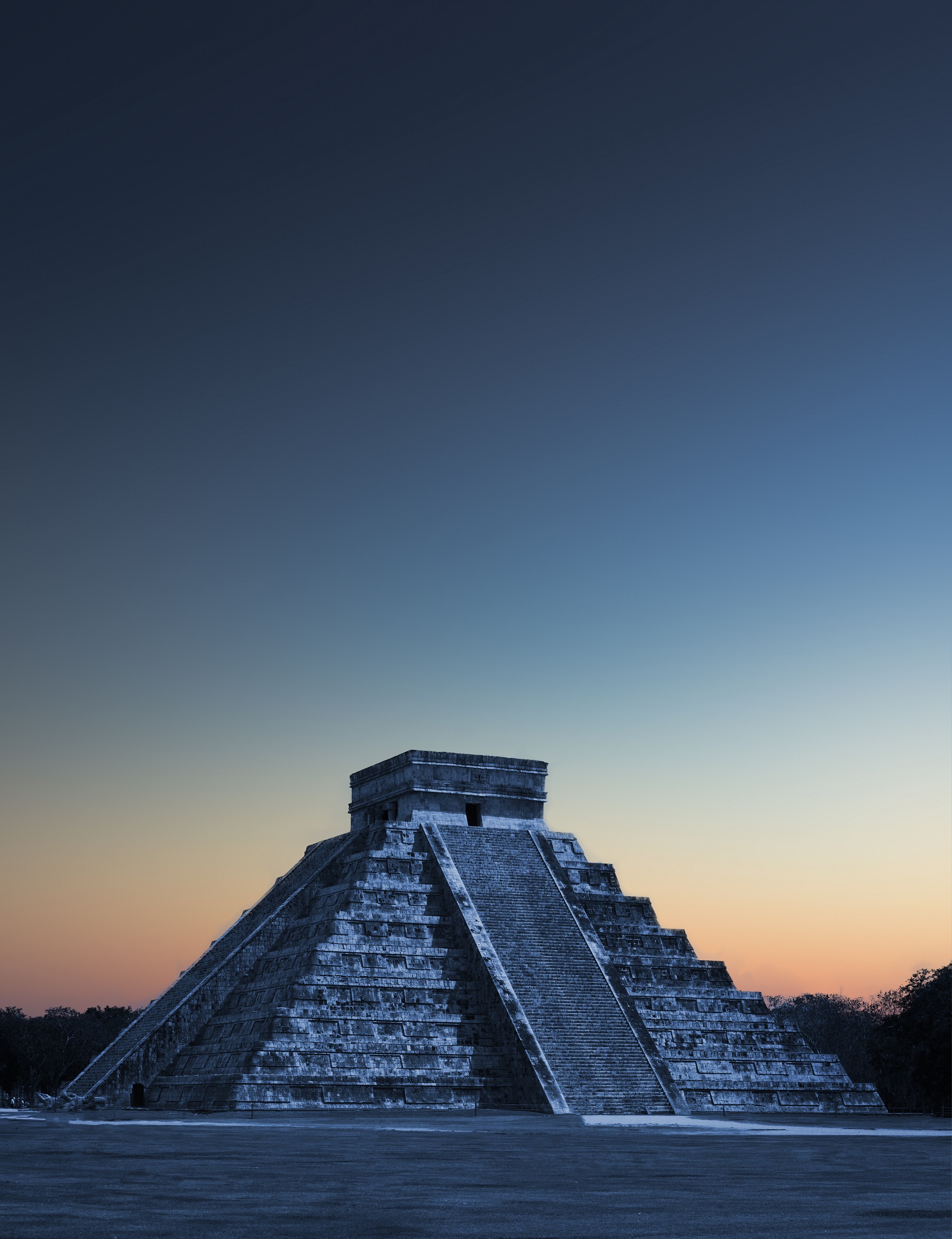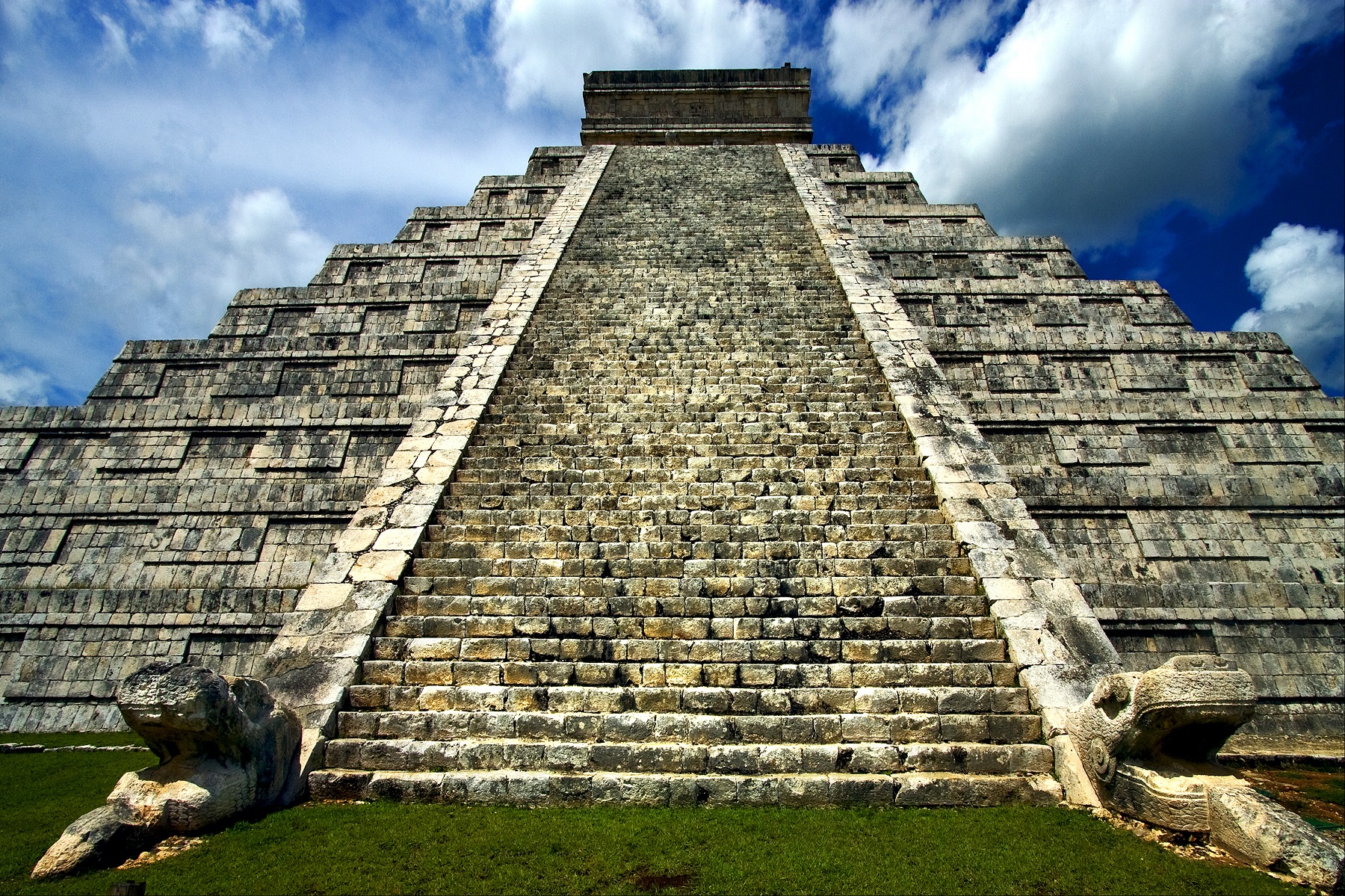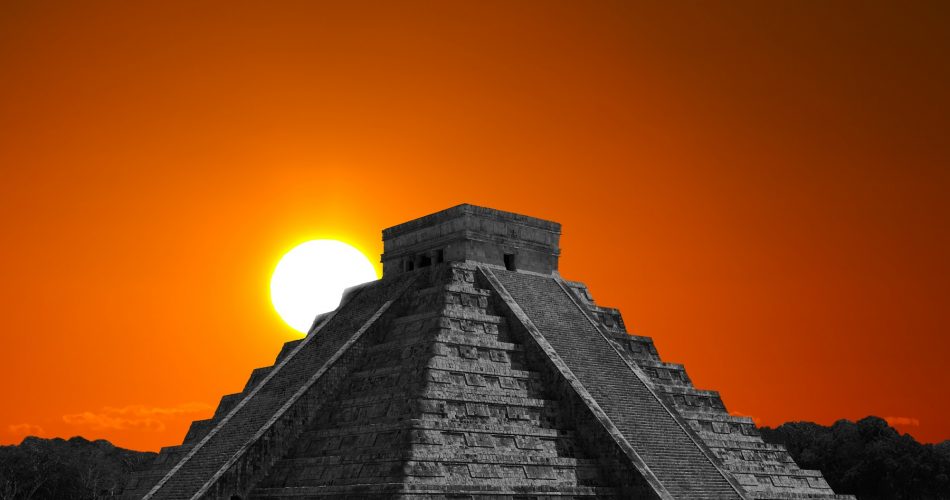One of the most famous pyramids in Mesoamerica is located in the Yucatan Peninsula. Not far from popular tourist center Cancun (around a 4-hour drive) the pyramid of “El Castillo“–the Castle–is a wonder of ancient Maya masonry, architecture, and design, and is central to the city of Chichen Itza. The Pyramid, intricately aligned like many other ancient structures, was dedicated to the Feathered Serpent Kukulkan.
Known to archeologists as structure 5B18, the stunning stepped pyramid is thought to have been built by the pre-Columbian Maya civilization between the 8th and 12th centuries CE or AD. The pyramid was built in the city of Chichen Itza, and the pyramid of El Castillo is more famous as just Chichen Itza rather than The Castle.
The city where the pyramid was built was a major focal point in the Northern Maya lowlands, starting from the Late Classic well into the Postcallsic Period of the Maya.
Rich in history and culture, the ancient city of the Maya bears multiple architectural styles, indicative of multi-cultural ethnicities percent at Chichen Itza in ancient times, all of which eventually shaped the city into the mixed styles we appreciate today.
The most popular architectural sites on site are reminiscent of those found in Central Mexico, and the Puuc and Chenes styles of the Mayan Northern Lowlands. The city of Chichen Itza was one of the most important and largest cities of the Maya and was likely considered one of the mythical great cities referred to in later Mesoamerican literature.
The name, Chichen Itza, is translated into “At the mouth of the well of the Itza.”
However, like many other ancient cities scattered across Central and South America, this city once held a different name. Evidence in the Chilam Balam–chiefly 17th and 18th-centuries Maya miscellanies, named after the small Yucatec towns where they were originally kept–indicate a more ancient name given to the city prior to the arrival of the Itza hegemony.
The translation of the ancient name has been subject to debate. Although many agree that the first word of the ancient name translates into “seven,” the rest of the translation is subject to controversy. Therefore, numerous translations of the ancient name have been set forth by experts, which makes defining the ancient name extremely difficult.
Nonetheless, we can conclude that Chichen Itza was most likely called either Uuc Hab Nal (“Seven Bushy Places”), Uucyabnal (“Seven Great Rulers”), or Uc Abnal (“Seven Lines of Abnal”) in ancient times. This ancient name is recorded not only in the Chilam Balam but also in the hieroglyphic text at its very ruins.
The city was built at a strategic position, experts believe. There are four sinkholes–cenotes–surrounding Chichen Itza, which provided plenty of water to its inhabitants. Of the for cenotes, the most famous is the so-called Sacred Cenote or “Cenote Sagrado.”
It is believed that a legendary tradition at the city was the Cult of the Cenote, where the inhabitants would offer human sacrifice to the gods, specifically to the rain god Chaac. They would throw gold and jade ornaments as well as other valuables into the cenote as part of ritual practice. This theory was confirmed when in 1904, Edward Thompson, an American who bought the site, decided to drain the cenote, confirming the legends.

An image of the Step-Pyramid of El Castillo at Chichen Itza, the pyramid rises 79 feet (24 meters) above the main plaza. The pyramid has four sides, with 91 stairs, each facing the cardinal directions. Shutterstock.
The Castle: A pyramid for Kukulkan
The Pyramid of Chichen Itza is the city’s central, most important part.
Dedicated to the feathered Serpent known to the Maya as Kukulkan, this very same deity was worshiped by civilizations such as the Aztec but under a different name: Quetzalcoatl. For example, the largest pyramid on Earth, the Great Pyramid of Cholula–located in central Mexico–was also an ancient pyramid temple dedicated to the Feathered Serpent.
The pyramid rises 79 feet (24 meters) above the Main Plaza and is composed of four typical pyramid sides, each of which has 91 stairs facing the cardinal directions. Including the upper step on top of the pyramid, the pyramid was built with a total of 365 steps, which number the days in one solar year. This single feature speaks of the astronomical meaning the Maya attributed to the pyramid, which in turn tells us that the structure, its planning, and design were anything but random.
Its intricate design is once again showcased by the carefully sculpted feathered serpent statues that run down the side of the northern part of the pyramid.
This is another striking feature of the Pyramid of El Castillo.
Like many other pyramids around the globe, the Pyramid of El Castillo most likely underwent various construction stages. The archeological survey of the site suggests the last phase of the pyramid was completed between 900 and 1,000 CE. The substructure (inner pyramid) is thought to have been completed between 600 and 800 AD.
Intricate, imposing, with a deep, and higher meaning, the pyramid’s concept is based on Axis Mundi: in a geocentric coordinate system, this is the axis of rotation of the celestial sphere. During the 20th century, the concept of the Axis Mundi was used to make reference to the mythological concept representing the “the connection between Heaven and Earth” or the “higher and lower realms.”
Rising towards the sky as a latter leading to the cosmos, the pyramid of Chichen Itza certainly had the feeling, almost as if it were connecting the heaven to the cosmos.
The pyramid of El Castillo is unique since it is one of the world pyramids that features a hidden secret; there’s another pyramid (the substructure) inside the pyramid we see today. The substructure (or better said one of the substructures) inside El Castillo is 10 meters tall and is built at the core of the pyramid.
Evidence of the substructure was found more than 70 years ago when a survey of its interior revealed a smaller pyramid with a jaguar throne, decorated with Jade.
Further surveys of the Pyramid and its surrounding area revealed that the pyramid was built on purpose above a cavity filled with water, a cenote. This indicates that the builders of the pyramid were fully aware of the cenote’s existence and purposefully built the pyramid atop, most likely due to religious beliefs.
This cenote has been found to be around 82 by 114 feet (25 by 35 meters) and is approximately 65 feet (20 meters) deep. The water within the cave system runs from north to south.

A photograph showing the stairs of the pyramid of El Castillo at Chichen Itza that lead towards its summit. Shutterstock.
The alignment of El Castillo is truly magnificent. The builders placed the pyramid at the very intersection between the four cenotes; the Sacred Cenote, Xtoloc, Kanjuyum, and Holtún.
This otherworldly alignment further supports the position of El Castillo as an axis Mundi and denotes the importance of the structure itself in the everyday life of the Mayan inhabitants at Chichen Itza. The western parts of the pyramid are aligned to zenith sunset and nadir Sunrise, which in turn are connected to planting and harvesting seasons.
The orientation and design of the pyramid is unprecedented. During the spring and autumn equinoxes, the shadow cast by the setting sun gives the appearance of a snake undulating down the pyramid’s stairways. This further reinforces the idea that the pyramid was dedicated to the Feathered Serpent, and proves the delicacy by which the Maya built their temples.
Unlike the pyramids of Egypt, which are thought to have been tombs, the pyramids of the Maya were religious and ceremonial centers, and perhaps even observatories.
A recent survey of El Castillo has revealed that the pyramid sits above a layer of limestone around 16 feet (4.9 meters) thick. In other words, the Pyramid was built atop a limestone layer that sits above the massive cenote.

